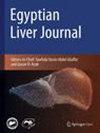Evaluation of serum thioredoxin as a hepatocellular carcinoma diagnostic marker
IF 0.7
Q4 GASTROENTEROLOGY & HEPATOLOGY
引用次数: 0
Abstract
Hepatocellular carcinoma (HCC) is one of the most prevalent and fatal malignancies worldwide. Following an increase in reactive oxygen species (ROS), cancer cells enter an oxidative stress state. As a result, these cells experience an increase in antioxidant activity to counteract oxidative stress. The thioredoxin (TRX) system is a ubiquitous mammalian antioxidant system that neutralizes ROS and maintains intracellular reduction oxidation (redox) balance, which is essential for HCC growth. However, the role of TRX protein in HCC remains largely unknown. Hence, we aimed to assess the diagnostic utility of serum TRX in patients with HCC. A total of 50 patients were consecutively recruited in this observational study. They were classified into three groups: an HCC group (25 patients), a cirrhosis group (15 patients with liver cirrhosis on top of chronic HCV infection), and a control group (10 healthy individuals). Serum TRX levels were measured using ELISA. Higher serum TRX levels were detected in the HCC group than in the cirrhosis and control groups (140.96 ± 12.70 vs 88.33 ± 10.34 vs 73.10 ± 13.22 ng/mL, respectively; P < 0.001). TRX was independently associated with the presence of HCC (P < 0.001). Regarding the detection of HCC, TRX at a cut-off value of 114 ng/mL had superior diagnostic performance to AFP with an AUC of 1.000, sensitivity of 100%, and specificity of 100%, whereas AFP at a cut-off value of 20.5 ng/mL had an AUC of 1.000, sensitivity of 100%, and specificity of 47%. Thioredoxin has the potential to be an HCC diagnostic marker. The clinical significance of thioredoxin in HCC requires further investigation.将血清硫氧还蛋白作为肝细胞癌诊断标志物的评估
肝细胞癌(HCC)是全球最常见、最致命的恶性肿瘤之一。随着活性氧(ROS)的增加,癌细胞进入氧化应激状态。因此,这些细胞的抗氧化活性增加,以对抗氧化应激。硫氧还原蛋白(TRX)系统是哺乳动物普遍存在的抗氧化系统,它能中和 ROS 并维持细胞内还原氧化(氧化还原)平衡,这对 HCC 的生长至关重要。然而,TRX 蛋白在 HCC 中的作用在很大程度上仍不为人所知。因此,我们旨在评估血清 TRX 在 HCC 患者中的诊断作用。在这项观察性研究中,我们连续招募了 50 名患者。他们被分为三组:HCC 组(25 名患者)、肝硬化组(15 名慢性 HCV 感染的肝硬化患者)和对照组(10 名健康人)。采用酶联免疫吸附法测定血清 TRX 水平。与肝硬化组和对照组相比,HCC 组检测到的血清 TRX 水平更高(分别为 140.96 ± 12.70 vs 88.33 ± 10.34 vs 73.10 ± 13.22 ng/mL;P < 0.001)。TRX 与 HCC 的存在有独立相关性(P < 0.001)。在检测 HCC 方面,临界值为 114 ng/mL 的 TRX 的诊断性能优于 AFP,其 AUC 为 1.000,灵敏度为 100%,特异性为 100%,而临界值为 20.5 ng/mL 的 AFP 的 AUC 为 1.000,灵敏度为 100%,特异性为 47%。硫氧还蛋白有可能成为诊断 HCC 的标志物。硫氧还蛋白在 HCC 中的临床意义有待进一步研究。
本文章由计算机程序翻译,如有差异,请以英文原文为准。
求助全文
约1分钟内获得全文
求助全文

 求助内容:
求助内容: 应助结果提醒方式:
应助结果提醒方式:


